Abstract
The reaction of oxyhaemoglobin and acetylphenylhydrazine, which results in haemoglobin denaturation and precipitation, was found to be influenced by H202 and superoxide (O2-.) generated during the reaction. By analysing the different haemoglobin oxidation products, it was found that by influencing the rate at which oxyhaemoglobin was oxidized, H2O2 accelerated the overall haemoglobin breakdown, and O2-. inhibited it. By adding GSH (reduced glutathione) or ascorbate, it was possible to slow down the rates of both oxyhaemoglobin oxidation and O2-. production, and the overall rate of haemoglobin breakdown. These results are compatible with a mechanism involving production of the acetylphenylhydrazyl free radical, and with GSH, ascorbate and O2-. acting as radical scavengers and preventing its further reactions. The reaction produced choleglobin, as well as acetylphenyldiazine and methaemoglobin, which combined to form a haemichrome. The haemichrome was less stable and precipitated first. It was also less stable than the haemichrome formed by direct reaction of acetylphenyldiazine with methaemoglobin, and it is proposed that this is because the methaemoglobin produced from oxyhaemoglobin and acetylphenylhydrazine was modified by the free radicals and H2O2 produced in the reaction.
Full text
PDF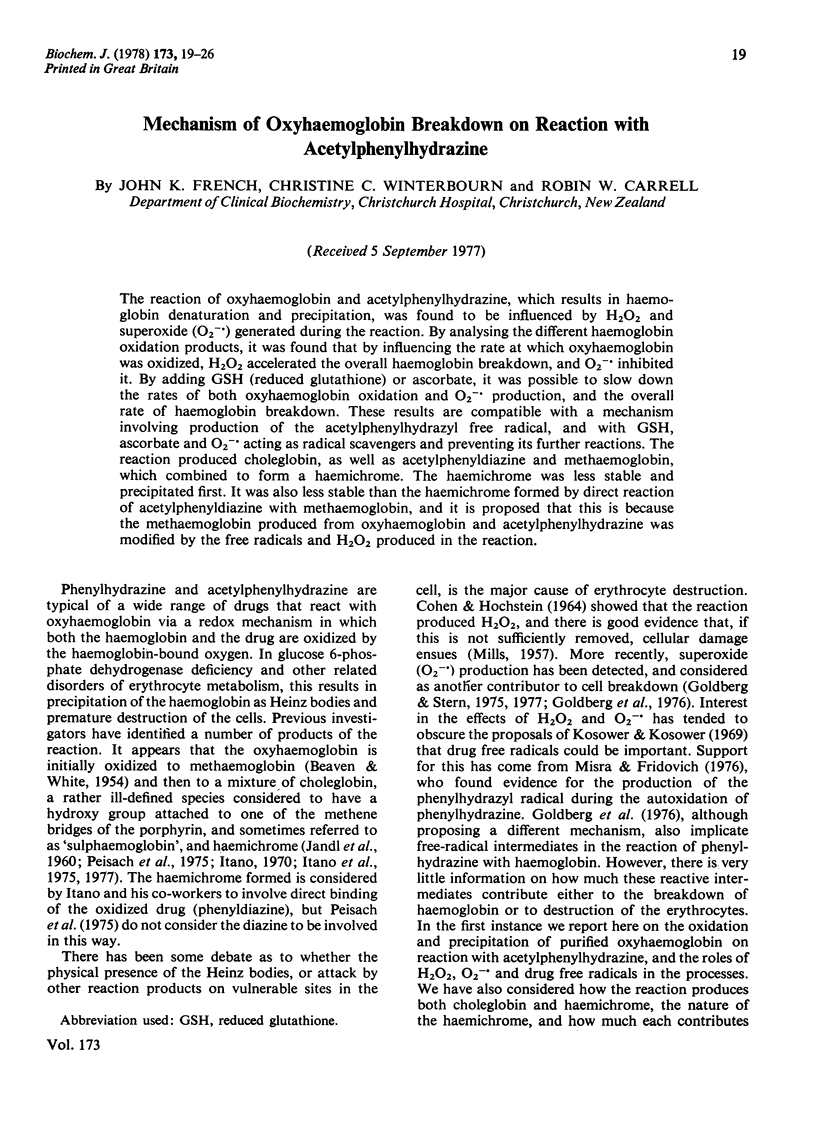
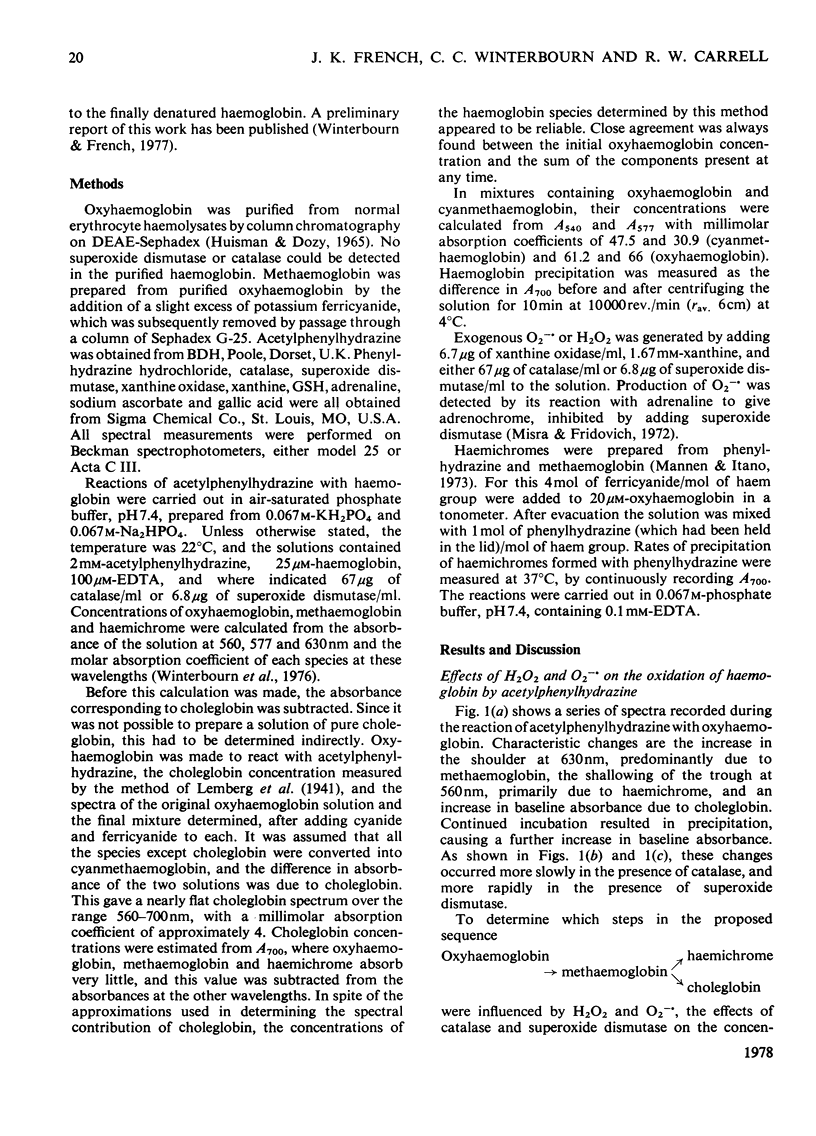
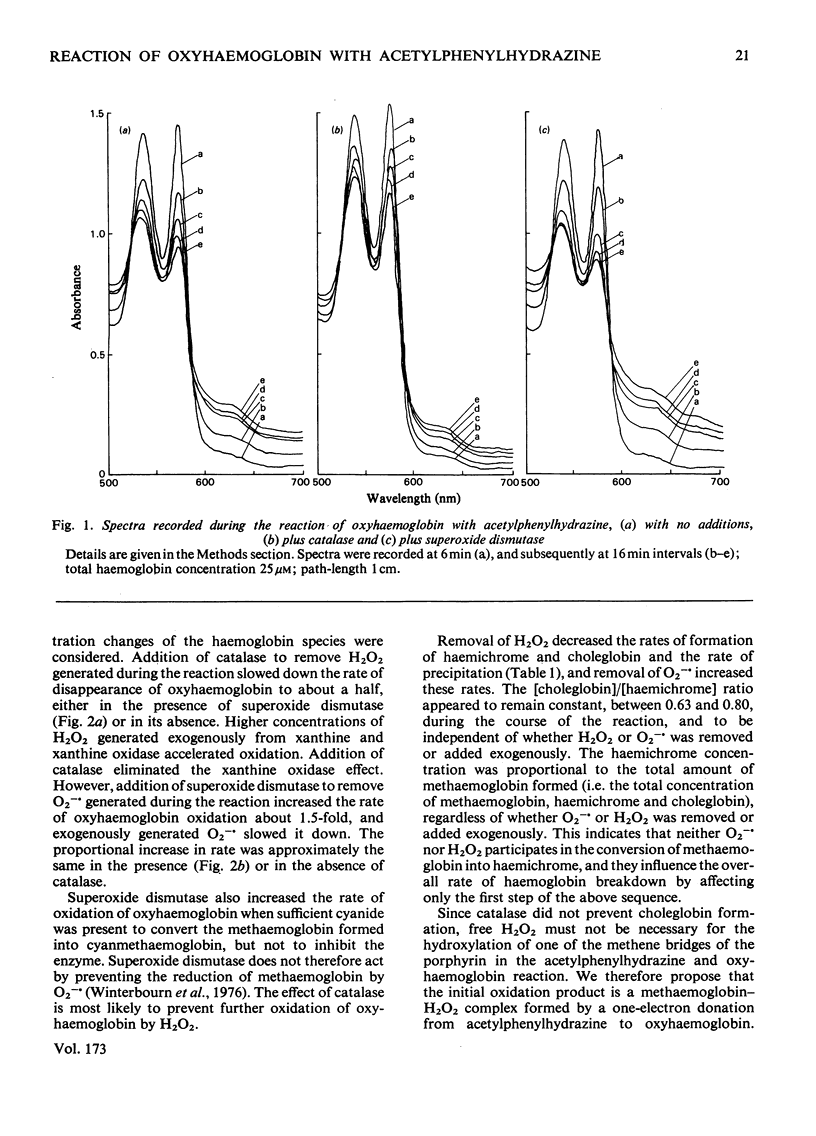
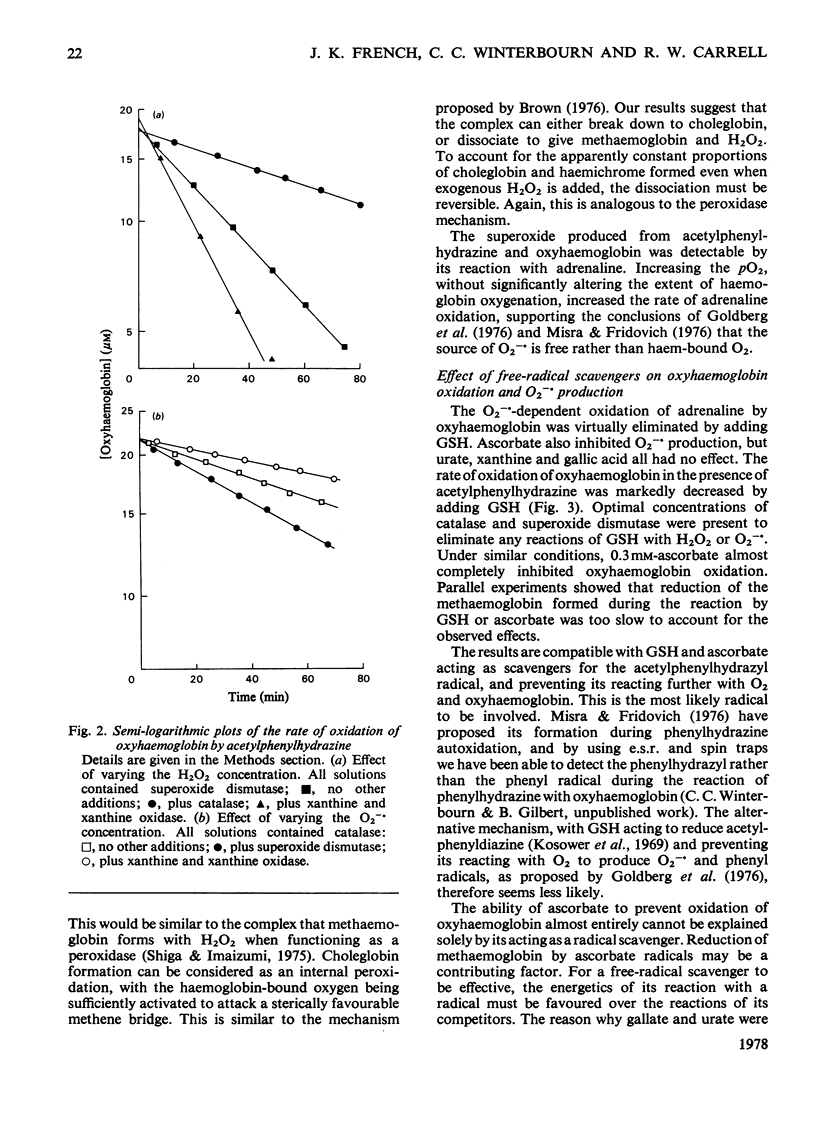
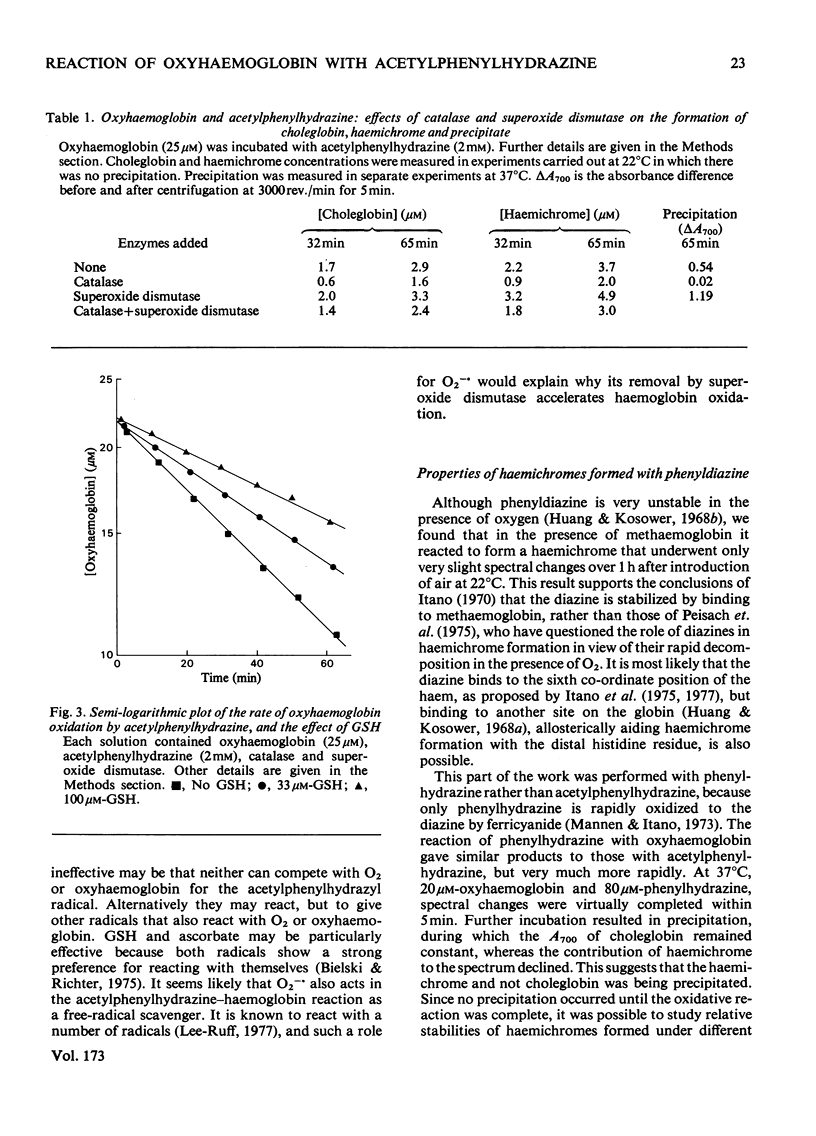

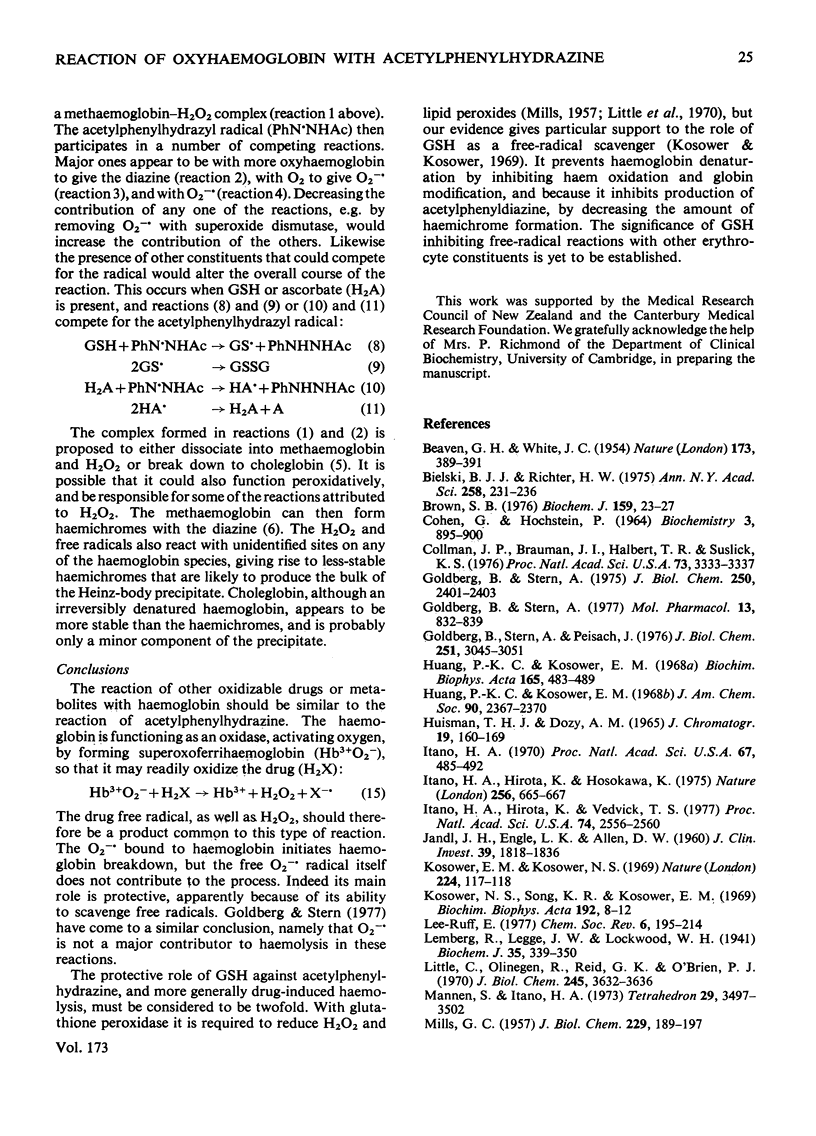
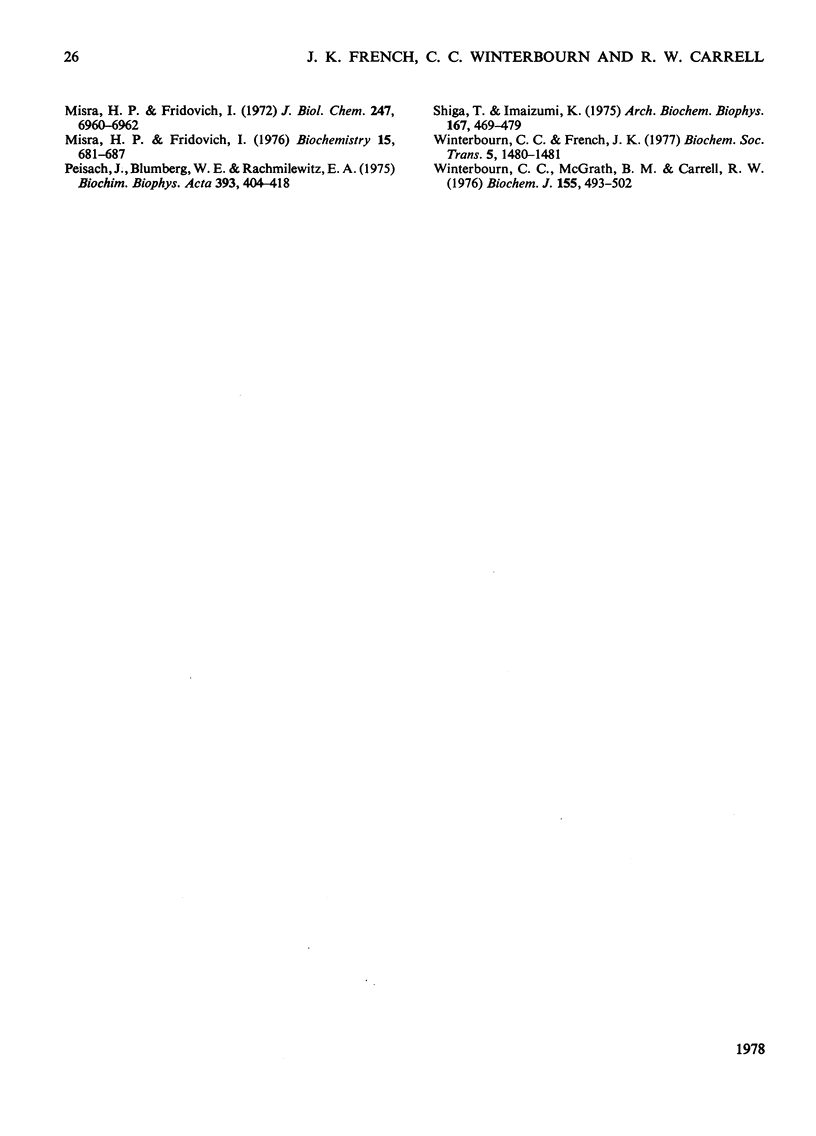
Selected References
These references are in PubMed. This may not be the complete list of references from this article.
- BEAVEN G. H., WHITE J. C. Oxidation of phenylhydrazines in the presence of oxyhaemoglobin and the origin of Heinz bodies in erythrocytes. Nature. 1954 Feb 27;173(4400):389–391. doi: 10.1038/173389b0. [DOI] [PubMed] [Google Scholar]
- Bielski B. H., Richter H. W., Chan P. C. Some properties of the ascorbate free radical. Ann N Y Acad Sci. 1975 Sep 30;258:231–237. doi: 10.1111/j.1749-6632.1975.tb29283.x. [DOI] [PubMed] [Google Scholar]
- Brown S. B. Stereospecific haem cleavage. A model for the formation of bile-pigment isomers in vivo and in vitro. Biochem J. 1976 Oct 1;159(1):23–27. doi: 10.1042/bj1590023. [DOI] [PMC free article] [PubMed] [Google Scholar]
- COHEN G., HOCHSTEIN P. GENERATION OF HYDROGEN PEROXIDE IN ERYTHROCYTES BY HEMOLYTIC AGENTS. Biochemistry. 1964 Jul;3:895–900. doi: 10.1021/bi00895a006. [DOI] [PubMed] [Google Scholar]
- Collman J. P., Brauman J. I., Halbert T. R., Suslick K. S. Nature of O2 and CO binding to metalloporphyrins and heme proteins. Proc Natl Acad Sci U S A. 1976 Oct;73(10):3333–3337. doi: 10.1073/pnas.73.10.3333. [DOI] [PMC free article] [PubMed] [Google Scholar]
- Goldberg B., Stern A., Peisach J. The mechanism of superoxide anion generation by the interaction of phenylhydrazine with hemoglobin. J Biol Chem. 1976 May 25;251(10):3045–3051. [PubMed] [Google Scholar]
- Goldberg B., Stern A. The generation of O2-by the interaction of the hemolytic agent, phenylhydrazine, with human hemoglobin. J Biol Chem. 1975 Mar 25;250(6):2401–2403. [PubMed] [Google Scholar]
- Goldberg B., Stern A. The mechanism of oxidative hemolysis produced by phenylhydrazine. Mol Pharmacol. 1977 Sep;13(5):832–839. [PubMed] [Google Scholar]
- Huang P. K., Kosower E. M. Complexes of phenyldiazene (phenyldiimide) with deoxyhemoglobin and ferroheme. Biochim Biophys Acta. 1968 Oct 15;165(3):483–489. doi: 10.1016/0304-4165(68)90229-8. [DOI] [PubMed] [Google Scholar]
- Huisman T. H., Dozy A. M. Studies on the heterogeneity of hemoglobin. IX. The use of Tris(hydroxymethyl)aminomethanehcl buffers in the anion-exchange chromatography of hemoglobins. J Chromatogr. 1965 Jul;19(1):160–169. doi: 10.1016/s0021-9673(01)99434-8. [DOI] [PubMed] [Google Scholar]
- Itano H. A., Hirota K., Hosokawa K. Mechanism of induction of haemolytic anaemia by phenylhydrazine. Nature. 1975 Aug 21;256(5519):665–667. doi: 10.1038/256665a0. [DOI] [PubMed] [Google Scholar]
- Itano H. A., Hirota K., Vedvick T. S. Ligands and oxidants in ferrihemochrome formation and oxidative hemolysis. Proc Natl Acad Sci U S A. 1977 Jun;74(6):2556–2560. doi: 10.1073/pnas.74.6.2556. [DOI] [PMC free article] [PubMed] [Google Scholar]
- Itano H. A. Phenyldiimide, hemoglobin, and Heinz bodies. Proc Natl Acad Sci U S A. 1970 Oct;67(2):485–492. doi: 10.1073/pnas.67.2.485. [DOI] [PMC free article] [PubMed] [Google Scholar]
- JANDL J. H., ENGLE L. K., ALLEN D. W. Oxidative hemolysis and precipitation of hemoglobin. I. Heinz body anemias as an acceleration of red cell aging. J Clin Invest. 1960 Dec;39:1818–1836. doi: 10.1172/JCI104206. [DOI] [PMC free article] [PubMed] [Google Scholar]
- Kosower E. M., Kosower N. S. Lest I forget thee, glutathione. Nature. 1969 Oct 11;224(5215):117–120. doi: 10.1038/224117a0. [DOI] [PubMed] [Google Scholar]
- Kosower N. S., Song K. R., Kosower E. M., Correa W. Glutathione. II. Chemical aspects of azoester procedure for oxidation to disulfide. Biochim Biophys Acta. 1969 Oct 7;192(1):8–14. doi: 10.1016/0304-4165(69)90003-8. [DOI] [PubMed] [Google Scholar]
- Lemberg R., Legge J. W., Lockwood W. H. Coupled oxidation of ascorbic acid and haemoglobin: Quantitative studies on choleglobin formation. Estimation of haemoglobin and ascorbic acid oxidations. Biochem J. 1941 Mar;35(3):339–352. doi: 10.1042/bj0350339. [DOI] [PMC free article] [PubMed] [Google Scholar]
- Little C., Olinescu R., Reid K. G., O'Brien P. J. Properties and regulation of glutathione peroxidase. J Biol Chem. 1970 Jul 25;245(14):3632–3636. [PubMed] [Google Scholar]
- MILLS G. C. Hemoglobin catabolism. I. Glutathione peroxidase, an erythrocyte enzyme which protects hemoglobin from oxidative breakdown. J Biol Chem. 1957 Nov;229(1):189–197. [PubMed] [Google Scholar]
- Misra H. P., Fridovich I. The generation of superoxide radical during the autoxidation of hemoglobin. J Biol Chem. 1972 Nov 10;247(21):6960–6962. [PubMed] [Google Scholar]
- Misra H. P., Fridovich I. The oxidation of phenylhydrazine: superoxide and mechanism. Biochemistry. 1976 Feb 10;15(3):681–687. doi: 10.1021/bi00648a036. [DOI] [PubMed] [Google Scholar]
- Peisach J., Blumberg W. E., Rachmilewitz E. A. The demonstration of ferrihemochrome intermediates in heinz body formation following the reduction of oxyhemoglobin A by acetylphenylhydrazone. Biochim Biophys Acta. 1975 Jun 26;393(2):404–418. doi: 10.1016/0005-2795(75)90069-0. [DOI] [PubMed] [Google Scholar]
- Shiga T., Imaizumi K. Electron spin resonance study on peroxidase- and oxidase-reactions of horse radish peroxidase and methemoglobin. Arch Biochem Biophys. 1975 Apr;167(2):469–479. doi: 10.1016/0003-9861(75)90489-0. [DOI] [PubMed] [Google Scholar]
- Winterbourn C. C., French J. K. Free-radical production from acetylphenylhydrazine and haemoglobin [proceedings]. Biochem Soc Trans. 1977;5(5):1480–1481. doi: 10.1042/bst0051480. [DOI] [PubMed] [Google Scholar]
- Winterbourn C. C., McGrath B. M., Carrell R. W. Reactions involving superoxide and normal and unstable haemoglobins. Biochem J. 1976 Jun 1;155(3):493–502. doi: 10.1042/bj1550493. [DOI] [PMC free article] [PubMed] [Google Scholar]


